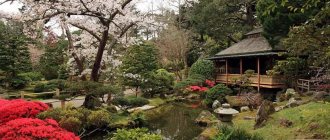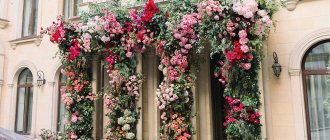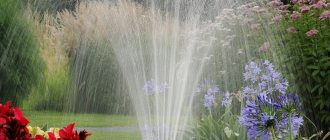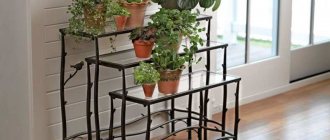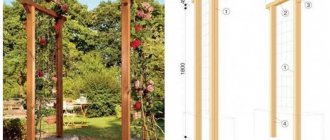Do you have your own house or summer cottage? Then this information is dedicated to you. The interior design of the yard is the pride of the owner. Of course, I want to show off the beautiful design. A flower garden will help make it so. An interestingly designed flower garden makes up 80% of a successful landscape design. We suggest using roses. You may think this is old and banal. But in fact, a rose can be different: refined, tender, playful, cheerful, noble, and accordingly, it gives this mood to the atmosphere, guests and owners.
The design of the yard should be beautiful, because this is the face of the owner
Roses are perfect for landscape design
Roses do not require special care
How to organize a rose garden on your property step by step
To ensure that the flowers in the flowerbed do not lose their beauty, the area must be properly decorated. Organizing the process step by step will save time and money. In the early stages, you can predict the slightest problems, so you should not abandon the sequence of measures.
Rose on a high trunk Source domvpavlino.ru
Flower garden along the fence Source pinterest.com
Place
For a rose garden in a dacha, you need an area that is as open as possible for viewing. Choose a place in the garden, near the main entrance or in a recreation area. If you hide expensive varieties and a complex structure in a remote corner, then the owners will not be able to enjoy a pleasant view.
An abundance of roses of rich cream color Source botanichka.ru
A capricious flower will not throw out buds if there is a lack of sun. Lack of rays negatively affects the shade intensity, size and health of crops. The bushes are drawn towards the light source and deform unsightly. For roses in landscape design, proximity to thick trees and high fences is contraindicated.
Support for roses in a flower bed Source nashgazon.com
Plants feel uncomfortable near the walls of buildings, especially on the western and northern sides. Unprotected from the bright sun, a rose garden in a dacha withers and burns within a few days. The ideal option for the location of the structure is 4 hours of lighting before and after lunch. Gardeners recommend a southern, windless slope.
See also: Catalog of companies that specialize in landscaping work on sites.
The soil
Roses in landscape design develop in an area with fertile soil. Wetlands and options with close groundwater are not suitable. The flower lives without problems in light loam, which has an acidity of pH 5-6 units. Before planting plants in the soil, they dig it up, add fertilizers (organic or mineral), and leave it for 90 days to settle.
High arch of pink climbing roses Source kmgram.com
Plan
If you think about the structure of the rose garden at your dacha in advance, then there will be no problems when planting. Decorative structures and flowers along the paths should not interfere with the movement of people. The parameters of the site and the distance to the nearest structures are noted on paper. The drawing will also help you choose the shades of plants and find optimal neighbors.
Frame with benches for climbing roses Source ooo-metallist.su
There are two types of layouts for roses in landscape design:
- Embossed. Clear boundaries and correct geometric shapes are observed, complex compositions and solo plantings are used. All elements are interconnected and emphasize the beauty of all plants.
- Landscape. The rose garden at the dacha looks like a natural extension of nature. Suitable for small areas.
Style
When decorating a flower garden, always adhere to style. For the ceremonial direction, bright buds and contrasting combinations are chosen. The entrance or path in white and red looks impressive. Yellow-orange roses in landscape design give the space a solemn sound.
Variety of roses in the flower garden Source studiofmp.com
The romantic style prefers classic varieties and shades and does not like sharp transitions. Pastel colors and gradients from delicate purple to white dominate here. To decorate a flower garden, choose a secluded area or a place that is significant to the owner.
Yellow roses for a bright rose garden in the country Source weibo.com
Advantages and disadvantages
Choosing a rose garden instead of a regular flower garden has many advantages:
- Roses are always beautiful, and their beauty, unlike other flowers, is to everyone’s liking.
- Simple care that doesn’t take much time.
- A rich assortment that allows you to create magnificent and unique compositions.
Of the shortcomings, the most significant is low frost resistance. But breeders have carried out full-scale work and solved this problem for many varieties. So today rose bushes can withstand our frosts.
Types of roses
To organize a beautiful flower bed, you need to choose the right variety of roses. Plants differ not only in shades, but also in the shape of the leaves, the height of the bush and the size of the bud. The most sustainable and unpretentious species are used in landscape design.
Climbing varieties have flexible trunks and inflorescences of small to large diameter. Tall bushes in the rose garden at the dacha are placed on special supports. The vegetation takes on the desired shape after cutting. Depending on the variety, the buds are double or simple.
Arch of pink roses for a summer residence Source ispaniagid.ru
Tea hybrids have an attractive appearance and resistance to disease. Due to its heat-loving nature, the crop freezes out at the first frost, so it is recommended for warm regions. Representatives of the variety have a delicate, recognizable aroma; the palette of shades varies from yellow to orange.
Floribunda is a profusely flowering species that has a long budding phase. The group includes both miniature potted roses and giants up to a meter in height. Representatives of the species can be recognized by their voluminous, lush brushes. Plants are not afraid of cold weather, but require regular pruning of fallen inflorescences.
Standard varieties develop in the form of a compact decorative tree with bright buds. The size of the crops varies from 45 cm to 1 m. In the rose garden at the dacha, tapeworm is often used as a noticeable accent of the composition. Plants look elegant on lawns, along borders and fences.
Standard roses on a support Source tunwma.com
Ground cover roses in landscape design are valued for their strong immunity and frost resistance. The shade range varies from delicate whites to reds. Varieties are used to create flowering canopies, hanging vines or decorative structures. Carpet types help fight soil erosion and hide dilapidated buildings or structures.
Shtrabs are flowering, strong, small bushes that are strewn with fragrant buds. These are often upright species, although a collapsing group is also found. Plants have strong immunity and resistance to frost. The popular Bonanza hybrid has rich yellow petals with a pink gradient border.
As a result of crossing multiflorous and Chinese roses, polyanthus species were obtained. Tiny buds are collected in voluminous tassels. Blooms abundantly until late autumn. Plants are not afraid of frost and are often grown in containers.
Roses for a beautiful flower garden in your local area Source ogorod.guru
Miniature ones resemble polyanthus hybrids in appearance, but the size does not exceed 50 cm. Representatives of the species are cultivated both in flower beds and in pots. The budding phase lasts until the first cold weather.
Patio are the smallest roses that develop poorly in height and retain dwarfism. Tiny flowers are collected in voluminous tassels. Plants will be an excellent addition to lawns, the edges of paths and will be a bright spot in a complex landscape composition.
Care
The key to a beautiful and long-living corner with roses is proper care. Naturally, the plant requires watering. When performing this task, monitor the required water level: do not overfill, but do not let it dry out.
Feed the flowers. Roses do not require special nutrition. However, they will benefit from additional soil nutrients.
The key to a beautiful and long-lived corner with roses is proper care
It is recommended to insulate roses for the winter
Meet the required lighting conditions in accordance with the type of plant.
Cover roses for the winter, as they are not frost-resistant.
As you can see, the rose is the queen of flowers, and everyone can cope with it. The main thing is proper care and creating a composition with a heart filled with love for flowers.
Expert opinion
Alina Kvileva
Landscape designer
Hello, my name is Alina and I am a landscape designer, if you have any questions regarding landscape design, ask, I will be happy to answer them.
See alsoCreate a cozy and beautiful garden plot with your own hands
How to plant roses beautifully: flower bed schemes
Roses are a popular element in landscape design. A properly selected planting scheme will allow each plant to develop to its maximum potential. There are several bright, memorable options that will help radically transform the site.
Wall of pink climbing roses on a frame along the fence Source ficbook.net
Small roses in a rock garden are a bright element of a flower bed Source bcons.com.ru
Vertical flower garden
For a rose garden at the dacha, you need to build a frame or use horizontal surfaces (roofs of buildings, crossbars) as supports. For vertical flower beds, climbing varieties are planted. A design solution will help disguise defects on the wall or hide a dry tree trunk. In order for the plants to hold better, you need to manually select the direction and fix it on the structure.
The garden often lacks volume and the picture looks flat. With the help of roses in landscape design, a third dimension is created. If flowers cover pergolas and trellises, they can easily transform a boring landscape. The solution is suitable for areas where there are no tall trees.
For a rose garden in a small country house, pillars are chosen as a support, between which festoons (ropes) hang. The structures look impressive along the paths, in the background of the garden. To prevent the structure from bending under the weight of greenery, it is better to install chains wrapped with twine.
Large rose buds for the main decoration of the front garden Source dizainvfoto.ru
Pyramids and obelisks dominate the site. In classic models, the height reaches 3 m, but for ease of maintenance, less bulky options are preferred. Climbing plants envelop the frame, turning the structure into a floral sculpture.
Hedge
A popular technique is used for zoning space, decorating a facade or separating an area. For roses in the landscape design of dachas, special arches are assembled. The structure will become a symbolic entrance to a garden or a special area:
- resting-place;
- secluded area;
- festive part.
The flower corridor of several designs looks impressive and unusual. Weaving varieties are used in delicate and bright versions. For a rose garden at the dacha, plants can be planted near the fence. In order for the structure to be visible from all sides, the crops need to be cascaded down the fence.
Abundance of roses along the house Source freemik.net
Border
Any type of flower is suitable for planting. In the low version, ground cover and dwarf hybrids look harmonious. Standard park roses in landscape design are successfully combined with tea and climbing roses. The composition is enclosed in strict geometric shapes, which give the structure an original appearance.
Border roses in a flower garden - a universal decoration Source lizgard.com.ua
The rose garden at the dacha can be laid out in the form of a flower garden visible from several sides. The design is reminiscent of a multi-layered wedding cake. The tallest solutions are located in the center, and the small ones are closer to the edge. The gradual transition of sizes and play of shades create an unusual composition. Curbs follow the shape and direction of the paths.
Parterre
The flower garden looks impressive at the entrance to the house. The original combination of several flower beds forms whimsical pictures on the ground. In the center of the parterre, a standard “tree”, vertical structure or hedge is appropriate. Low and standard roses in landscape design are planted very densely, hiding soil gaps.
Many types of roses Source rsrub.ru
Drawing can be both complex and simple. Volumetric islands are reserved for miniature patios or ground cover varieties. Paved paths are laid between the elements or decorative gravel is poured. The border of the images will be ordinary lawn grass. To prevent the rose garden at the dacha from becoming a motley spot, you need to follow the rules of harmony.
Site decoration options and garden compositions
Climbing roses are ideal for vertical structures and creating hedges. If the composition has borders, then it is better to decorate them with varieties of the same name. Alone, floribundas and grandiflora look best.
Rosaries, or flower beds consisting only of roses, are:
- Front doors. Bright, often contrasting in color varieties are used.
- Vertical. Climbing varieties decorate gazebos or pergolas.
- Romantic. Planted near recreation areas to create an appropriate environment.
- Visible on one side. This is the best way to decorate the inside of a fence or building wall.
- Visible from all sides. In this way, the central parts of the garden or open lawns are decorated.
- Mobile. To do this, roses are planted in slides, which can be easily moved and carried if desired.
- Rock gardens. Preference is given to low-growing varieties, which are combined with stones and boulders.
Below we will talk about what garden compositions can be created using roses.
Vertical rose garden
To create this composition it will be necessary to build a frame. The frame can be the roof of a nearby building, a staircase, or any artificial support.
Climbing varieties are planted at a short distance from each other. An excellent solution would be to alternate climbing plants with clematis.
You need to combine plants according to the color of their buds. To get a contrasting flower garden, combine white and blue clematis with scarlet roses. For more pastel compositions, a combination of yellow and pink flowers is suitable.
Hedges and arches
If the territory needs to be divided into zones or simply to “cover up” something ugly, a hedge will be the optimal and stylish solution. For this purpose, bushy and climbing varieties of royal roses are used.
The transition from one zone to another can be emphasized with arches. They will create the atmosphere of entering a special, secret, secluded corner of the site.
Arches can be made from scrap materials or bought ready-made. Only climbing varieties of roses are suitable for decoration. Such passages look wonderful.
Roses are planted in the fall if the variety is grafted in the conditions of a particular region. Brought seedlings are dug in in the spring. Over the summer, plants calmly adapt to the climate.
Mobile flower garden
The mobile flower garden is not tied to a specific location. Plants are planted in large containers, pots and flowerpots. Each element becomes a module that is used for decoration. In landscape design, roses are placed:
- along the edges of the paths;
- near houses;
- on the terraces.
Dwarf patios can be hung in planters in a gazebo or on a tall tree in a seating area. For a rose garden in the country, old garden carts or baby strollers are used. Large plants have a massive root system, so patio, mini and polyanthus varieties are used for landscaping. To prevent crops from getting sick, they cannot be constantly moved.
Source ogorod.ru
Roses in landscape design are often placed next to bodies of water. Compact fountains or small pools with a strict geometric shape are suitable for a mobile flower garden. Containers are placed around the perimeter of the sides or installed in a bowl.
What plants to plant with roses for the background
The structural design of the rose garden at the dacha creates a clear picture in the garden. The flower is the canvas and the lawn is the frame. Plants in the phase of throwing out buds look most advantageous against a background of greenery. The inclusions are relevant for borders, parterres and alpine flower beds. A base with a bright emerald tint helps to highlight the texture of the structures.
Square plots for rose gardens on a large plot Source bonjourparis.com
The rose occupies a central place in landscape design. The remaining plants emphasize the importance of ornamental culture. Leartis and lavender will form the background. On the lower tier, periwinkle creates a pleasant green carpet with blue stars. The perimeter of the flower bed is decorated with bells and aquilegias.
The rose garden at the dacha is fenced off with barriers. Juniper will protect the plant from the wind and highlight the beauty of the flower. Compact thuja and spruce trees will be good neighbors. Evergreen magnolias, cotoneaster and pyracantha will not disturb the composition. A spectacular beauty will make friends with lilac and privet bushes.
Beautiful surroundings of the house with lush flowers Source landshaftdizajn.ru
In landscape design, roses are combined with hosts. Decorative foliage of low-growing species is collected in lush rosettes. A kind of border hides the unsightly parts of the bushes. If you fill the lower tier with marigolds, you can additionally protect the flowerbed from diseases and insects. The following is used as a fence:
- cosmos;
- nasturtiums;
- gaillardia.
Rose and landscape design styles
The royal flower fits universally into almost all the ideas of a landscape designer. Elegantly and organically combined with bright, exotic styles: colonial or Moorish.
It also fits most harmoniously into the classic English style. A combination of rose bushes with sculptures, embodying the romantic Provence and ethnicity of the French style. It is impossible to imagine Spanish style without decorating the terraces with roses.
Wise and philosophical Japan accepts into its garden of reflection not only sakura, but also the beautiful rose. This flower looks equally advantageous in both Russian folk style and brutal country style.
How to properly care for a rose garden
To prevent roses in landscape design from losing their beauty, you must follow the basics of agricultural technology. During the growing season, regular watering is required. Plants are sensitive to the level of moisture in the soil. When there is a shortage of water, the buds drop; when there is too much water, the root system rots and fungi arise. In hot mornings they turn on sprinkling, and in cold summers they don’t get carried away with irrigation.
Tall standard roses for decorating a dacha Source news.hitsad.ru
Flowering plants love feeding. To ensure that the rose garden at your dacha does not lose its decorative appearance, you need to regularly apply fertilizer. Organic matter contains a lot of nitrogen, which is only relevant during planting and in the spring. In summer, a mineral potassium-phosphorus preparation is used once every 2 weeks.
Early pruning helps crops maintain a healthy appearance.
For climbing varieties, only weak branches from last year are removed. In tea hybrids, all vines are shortened by 2/3, in strabovyhs, diseased shoots are shortened to the root collar. Floribunda shoots are renewed by a third.
Correct calculation of seedling planting depth Source ogorod.ru
In the fall, they stop irrigating and fertilizing. Before the first frost, rose bushes are mulched with sawdust and covered with spruce branches and fallen snow. As soon as warm weather sets in in the spring, the structure is removed.
Planting a rose seedling: deepening and pruning Source agronomwiki.ru
Selection of varieties
The rose has been a recognized popular garden flower for several centuries. Today, flower growers can choose seedlings from a variety of varieties. The petals of inflorescences in different species and varieties are found in both simple and double forms. The list of suitable varieties for the rose garden includes:
Hybrid tea varieties
These roses are distinguished by erect shoots, medium and often very large single flowers. Hybrid tea varieties are used for cutting and when making bouquets. Caring for roses is difficult; they place high demands on the gardener in terms of agricultural technology. Popular varieties include: Mauritius, King Arthur, Broceliande, Rose Gaujard, Copacabana, Imperatrice Farah, Corfu, La Palma.
Floribunda roses
These flowers are not for bouquets, but the variety is often used for group plantings. On each bush, the inflorescences are collected in brushes. Characteristic features include: an abundance of flowers and a long flowering period. This category includes the following varieties: Kronprinsesse Mary, Cream Abundance, La Sevillana.
Shrub species
Shrub roses are divided into three categories: old, wild and repeat blooming. The most popular varieties include Nadia Renaissance and Concerto. Shrub species are planted in rectangular and round flower beds. This allows you to emphasize the elegance and elegance of the rose garden. The main advantage of bush roses is their large, brightly colored flowers.
Patio
This type of rose was obtained during the selection of floribunda varieties. Patio bushes are low, up to 50 cm. A distinctive feature of the patio is the abundance of inflorescences and long flowering. Flowers of this variety are often planted on terraces. The most popular types of patios are: Mauritius, La Palma.
Miniature varieties
Small bushes are decorated with small leaves and flowers. Rosettes of different shades appear on compact plants. Often miniature varieties are grown as indoor plants. Flowering is always abundant.
Climbing varieties
These roses require support and regular pruning. Climbing varieties bloom only once per season. The bushes are also distinguished by a large amount of greenery. This variety includes the following varieties: Boogie-Woogie, New Dawn, Penny Lane, Laguna. Climbing roses are used to decorate gazebos and arches. Plants have rigid stems and are highly resistant to pests and fungal diseases. There are varieties that bloom two or three times in one season. Climbing varieties have a great advantage: they are unpretentious in maintenance.
Standard varieties
Standard roses are placed in a separate category. This is the name given to flowers that were obtained using scion and rootstock. The rose cutting is placed first, and the rose hip cutting is placed second. The standard used for grafting climbing varieties is distinguished by its impressive height, up to one and a half meters. This method of growing is complex and requires knowledge and accuracy. Standard varieties are planted next to low-growing plants.
Ground cover roses include creeping, spreading and shrubby varieties. Leafy bushes have a dense crown and shoots higher than half a meter. If you combine these types, you can decorate areas of the yard and garden that are not particularly attractive.
conclusions
Roses are considered one of the most beautiful and fragrant flowers. In order to grow such flower waterfalls, you need to follow certain recommendations and properly care for the plants. This concerns the choice of location, feeding, and other important processes.
If grown correctly, your flowerbed will be rich in these noble bushes.
Requirements for placement of seedlings
If you are setting up a classic rose garden, you will need a large garden plot. On an area of 15 m² you can place up to 25 large bushes. Among the good places for placing rose bushes, in addition to the main entrance, there is a slope on the south side, made in the form of terraces. For a decorative effect, make four to five tiers. Ground cover and climbing varieties can be grown in terraced rose gardens.
The area for planting seedlings should be well lit and protected from strong gusts of wind and drafts.
You should not plant rose bushes near fences or under trees with a dense spreading crown. When planting seedlings, it is necessary to avoid those places that are flooded with melt and groundwater in the spring. Places that are too dry should not be allowed. Flowers do not like drought as well as waterlogging.
It is better for plants when the soil is drained, fertile and moderately acidic. Fertilizers include rotted chicken manure, ash, river sand, peat and leaf compost. When organizing a rose garden, you need to focus on the condition of the soil. For light sandy soil you will need a weathered clay additive. It is often replaced with turf soil. The design of a flower garden of rose bushes must be approached responsibly. In order for the rose garden to live up to expectations, you will need to work hard and put in a lot of effort in the first years.
Making a rose garden from ground cover roses
Stage #1 – choosing a landing site
The development and growth of a groundcover rose, like any other, is significantly influenced by the following factors:
- illumination and slope of the landing site;
- temperature regime;
- soil moisture;
- soil acidity;
- planting density.
Roses are light-loving plants - intense insolation of the planting site promotes long-term flowering and abundant formation of buds due to the rapid movement of nutritional ingredients from the soil to the plant and optimal evaporation of moisture from the surface of the foliage. It is desirable that the place for planting roses has a slope of about 7-11 degrees to the southeast or west, is well lit by the sun in the first half of the day, and in the hot afternoon hours is in the shade. If the roses are exposed to the scorching rays of the sun for most of the day, their color will fade, the petals will “burn” and they will quickly fade.
To prepare a good place for a rose garden, consider the soil requirements:
Miniature perennials planted in the foreground of medium-tall groundcover roses highlight the beauty of abundantly flowering bushes
The proximity of bushes and trees will help create the shade the roses need and, in addition, protect them from the wind. But at the same time, rose gardens should not be located at a short distance from large garden plants - they will take away nutrients and moisture from the roses, forming a zone of long-term shading. In poorly lit areas of the garden - near the walls of buildings and under the canopies of trees - the root system of the rose slows down its growth, the shoots become thin and weak, “blind” branches without flowers often form, and fungal diseases occur.
It is important to know! The slope of the rose planting area contributes to optimal insolation of the site, drainage of melt water in the spring, as well as effective soil drainage during heavy rainfall. In addition, rose gardens raised by 40-50 centimeters relative to the general level of the garden will practically not suffer from frost, since cold air naturally accumulates in the lowlands.
A neat small flower bed with carpet roses of different shades - a catchy accent for a green lawn
An essential characteristic of a site for planting roses is the degree of soil moisture and groundwater level. Roses do not tolerate wet soils very well, which prevent the circulation of oxygen, are too cold in winter and are highly acidic. Filling a gravel cushion into the planting hole will slightly alleviate this problem, but will not solve it completely, so it is better to drain water from a rose garden planted on wet soil using drainage pipes.
You can learn more about how to install a water drainage system on a site from the material:
The bark of coniferous trees, used as mulch for a rose garden, will protect the planting from pests, weeds and will help retain moisture in the soil
The temperature of the air and soil in the area where the rose garden is laid out is also important - the optimal indicators for air are 15-22 degrees, soil - 17-20 degrees. Both overheating of the earth and its low temperature are bad - in both cases, the development of the rose is inhibited, the number of flowering shoots is reduced. To prevent excessive heating of the soil between the bushes of ground cover roses, it is mulched with peat, humus, and freshly cut grass.
As for the composition of the soil, the most favorable soil for any roses is loamy, which transports moisture and oxygen well to the plant’s rhizome. Rose seedlings are poorly accepted in dry sandy soils, which overheat in summer, freeze in winter and do not retain nutrients well. Skinny sandy soils can be improved with compost mixed with peat, clay, and turf soil. Rocky and heavy clay soil is not entirely suitable for a rose garden; it is recommended to add sand, peat, compost, rabbit or rotted chicken droppings, and drain it with small grooves.
Blooming profusely throughout the season, ground cover roses in pastel shades create delicate frames for lawns and green lawns.
An interesting solution for garden decor could be a flower bed with ground cover roses that follows the contours of the path
Of fundamental importance for the successful cultivation of any varieties of roses, including groundcovers, in open ground is the acidity of the soil, since the royal flower is quite capricious - neither a critically acidic soil reaction with a pH less than 7, nor an alkaline one with a pH greater than 7 will work. The best option is soil with weakly acidic reaction in the range from 5.5 to 6.5 pH.
To determine the acidity of the soil, you can use litmus paper, which, when interacting with an aqueous solution of the soil, will change color to blue if alkalis predominate in the soil or to red if there is excess acid. More accurate soil analyzes are carried out by specialized agricultural institutes. Soils with high acidity are neutralized with crushed limestone, gypsum, bone or dolomite flour, and ash. If the soil reacts alkaline, it is acidified with superphosphate, sulfur, peat, pine or leaf humus.
Recent Entries
Lilac perennials that are beautiful, compact and do not crowd out other plants Why when buying seedlings you should not take the sellers’ word for it and how to determine the age of the plant using 3 signs Tomato seedlings have turned purple or whitish: why the color has changed and how to save the plants
You can learn more about how to lim the soil in the garden from the material:
Due to the three tiers formed by creeping and standard roses in combination with lavender, a small rose garden looks like a bright accent in the garden landscape
Thanks to multiple miniature inflorescences, a rose garden of ground cover roses is always a catchy and spectacular corner of the garden
Before setting up a rose garden, it is also necessary to analyze what crops grew previously in the selected area. It is unacceptable to plant roses where a rose garden has already existed for 7-10 years or where Rosaceae have grown - hawthorn, serviceberry, pear, apricot, cherry, etc. Although, if desired, depleted soil can be selected to a depth of 50 cm and replaced with a fertile mixture consisting of clay, compost, mineral fertilizers, humus or well-rotted manure.
Ground cover roses can become a harmonious addition to a multi-level hedge, forming the middle or lower tier
With their abundant color, ground cover roses form a colorful carpet that can liven up a fence or pergola.
When placing ground cover roses in compositions with other garden plants - in mixborders, flower beds, it is advisable to provide optimal distances between planting groups so that it is convenient to approach the flowers for pruning, fertilizing, watering, without damaging their “neighbors”. The distance between rose bushes in a flower garden ranges from 30 centimeters to a meter and depends on the characteristic features of the variety, the shape and size of the bush, and the intensity of shoot growth.
Stage #2 – preparation for landing
It is best to prepare holes for planting ground cover roses in advance - at least several weeks before moving the seedlings into the ground. For autumn planting, it is optimal to form holes in the spring, for spring - in the fall, having previously marked the area taking into account the shape and growth of the bushes:
- Seedling in a container. Despite the fact that suppliers of planting material advise planting a rose in a net, often its root system is not properly prepared for this procedure - the tips of the root shoots are bent or broken. Therefore, the rose rhizome must be carefully removed from the packaging, shortened to 30-35 centimeters, and broken or damaged shoots removed. However, most often the integrity of the coma is not violated, but in order to stimulate the growth of the root system, several cuts are made in it to a depth of about 2 cm.
- Sapling with open rhizome. If a landscape rose seedling was purchased with an open, trimmed root system, then before planting it is recommended to update its cuts. With this root system, drying out of its shoots is often observed, so we advise you to keep the roots of the flower in water for 24 hours before moving it to open ground.
High-quality and viable rose seedlings should have three well-developed shoots and a fairly branched root system with a significant number of small shoots. Please note that the diameter of the rootstock and scion is the same - within 6-8 centimeters. Before planting in the garden, the foliage and buds located below the grafting are removed from the flower shoots, broken and immature branches are cut off, the rhizome is shortened to approximately 20-35 cm in length, and the above-ground part is shortened to 25-35 cm. Before planting ground cover roses in the garden plot, it is recommended disinfect the seedlings with 5% copper sulfate, and dip their roots in a creamy mixture of clay mash and mullein in a 2 to 1 ratio.
You can grow a rose from a cutting yourself, read about it:
Snow-white foam woven from ground cover rose flowers will give a decorative flower border an amazing flavor
The extraordinary popularity of ground cover roses has led to the creation of hybrids that combine the qualities of carpet and standard roses
The extraordinary decorative color of ground cover roses, combined with their unpretentiousness, has earned these varieties massive popularity among gardeners
The ground cover rose will create a truly unique corner of the garden, expressive due to the many inflorescences that form a living floral carpet
Lushly blooming carpet roses are an expressive solution for arranging a flower bed near the house
Stage #3 – we analyze the types of seasonal planting
For regions with warm winters, autumn planting of creeping and carpet roses in open ground is more preferable, and for regions with harsh and frosty winters, spring planting is preferable.
Spring planting of roses (April-May)
Often, unfavorable weather conditions in spring prevent the planting of a seedling immediately after purchase, so you need to take care of its safety - place it in a box or bucket, cover it with moistened sand above the grafting and cover it with a film stretched over the frame. You can store seedlings in a cool room or in a trench. Having chosen the most elevated place on the site, dig a trench about 50 cm deep with one gentle slope, pour sand on the bottom and place rose seedlings in the trench, having first shortened their rhizomes to 30-35 cm. Roses must be laid on the inclined side of the trench, placing spruce branches and burying the flower in the trench 10 cm below the graft or root collar. Having sprinkled the seedling with sand, water and compact this layer, and then cover it with earth and cover it with spruce branches.
When planting roses in the ground in the spring, all rose shoots are pruned so that strong plants have 2-3 buds left, and weak ones - 1-2. Although the shoots of carpet roses are most often not pruned, but only the root shoots are shortened.
Landing
First of all, you should pay attention to the place where the flowers are planted. A well-lit, wind-protected piece of land is best. Among the characteristics of the plant, one can highlight the fact that they are quite sensitive to sunlight and heat.
The south, southeast side will be an ideal location. You should consider the basic recommendations on how to grow roses.
The most favorable time for planting is spring. After all, roses are heat-loving plants. When the soil warms up at least a little, they begin planting. Roses are rarely planted in the fall. This is a big risk, because not all rose bushes will be able to take root before the cold weather sets in.
Pay attention to the roots of the plant. The roots should not exceed 15-20 cm. If you notice damaged or dried areas, you should cut them off.
The hole for planting the plant should be deep and wide enough. Then it is covered with a layer of earth and watered abundantly. When watering, you must follow the rule: for one bush - one bucket of water. Cover the roses with non-woven material. It will serve as protection from spring sun rays.
Prepare the soil properly. It should be filled with mineral, organic fertilizers. The latter type includes manure, which acts as additional feeding. When fertilizing with mineral fertilizers, take into account the proportion: maximum 15-20 g per rose bush. The fertilizer should be evenly distributed; its excess will negatively affect the further flowering of roses.
Most often, the soil for planting is prepared in the autumn season. The depth of the pit is 1.2 m, its diameter is 0.5 m. It should be filled with branches, expanded clay, crushed stone, then earth with humus and mineral components should be laid. If planting occurs in the fall, prepare the site a month in advance.
Seedlings of the first two years, as you can see in the photo of roses in the garden, are best suited for planting. To stimulate their growth, the tops should be trimmed periodically.
The optimal spacing for planting is 0.5-1 m. Although this recommendation can be neglected, depending on individual preferences and the goal. In particular, large bush roses look beautiful alone. They should be seated keeping a certain distance.
If we are talking about planting small bushes, then the distance is 60-70 cm. Most often, such bushes are planted in order to create borders near paths or flower beds.
Climbing roses are among the single flowers. They grow quickly, so a certain distance should be maintained when planting them. To create a “wall”, this type of roses is used. When transplanting flowers, be as careful as possible so as not to damage the root part or roots.


